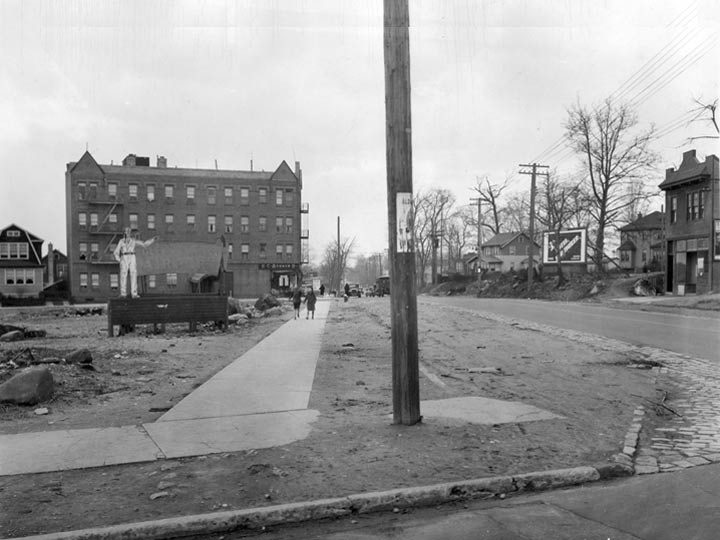LaGuardia Airport was constructed in 1929 as Glenn Curtiss Field, and later, North Beach Airport, replacing a former North Beach amusement area called the Gala Amusement Park, opened in 1889 by piano master William Steinway and beer baron George Ehret; it fell flat when Prohibition was enacted in 1920. The North Beach area and park were served by the Brooklyn City Railroad, which operated a trolley line along Old Bowery Bay Road, once one of the only thoroughfares in eastern Jackson Heights and East Elmhurst. The line survived into the 1930s and served the airport for a time. The airport was expanded to a full-service NYC airport beginning in 1939, and is currently undergoing massive renovations that will add new terminals and other amenities.
Glenn Curtiss (1878-1930) was a motorcycle manufacturer who became an early aviation pioneer.
On July 4 [1908], Curtiss piloted the “June Bug” across Pleasant Valley for a distance of 5,090 feet – 1,810 feet farther than required. No less important, it was the first officially-recognized, pre-announced and publicly-observed flight in America. It won Curtiss the first leg of the trophy and established him as America’s foremost aviation pioneer. In 1909, he flew his “Golden Flyer” a distance of 24.7 miles to establish a new world distance record and win the second leg of the Scientific American trophy. Later that same year, in Rheims, France, competing against Europe’s top aviators, he won the Gordon Bennet Cup speed race, averaging 46 mph. In 1910, when the New York World Newspaper offered a $10,000 prize for the first successful flight between Albany and NYC, following the Hudson River, Curtiss again determined to be first, and did so in a craft he had named the “Hudson Flyer”. He won the prize money, nationwide recognition, and in the process, won the third leg of the Scientific American Competition and permanent possession of the coveted trophy. It was his much-publicized Albany to New York flight that established the aeroplane as having some practical value. [Glenn Curtiss Museum]
There’s a lot going on in this 1932 photo looking west at Astoria Boulevard at 94th Street. At left, a billboard points the way to Glenn Curtiss Airport. In 2020, 94th Street remains an important approach point to LGA from the south and was also part of the route the streetcar line took to get to North Beach.
The apartment building with the peaked cornices at 93rd Street remains in place, as well as the private home yo the right of the billboard across Astoria Boulevard.
At the time, Astoria Boulevard was still a modest two-lane highway. Change is in the offing, however. You can see that ground has been cleared to the right of the telephone pole in the foreground. this was part of Astoria Boulevard’s expansion into a 6-lane behemoth, 8 if you count the parking lanes, all part of the construction of the Grand Central Parkway through Queens in the 1930s. West of 80th Street, Astoria Boulevard serves as the GCP’s service lanes. In the 1930s, transportation was quickly moving away from the old horse and buggy days to fossil fuel powered automotive and flying vehicles. Environmental ramifications for all this are under discussion in the 2020s.
The photo was snapped by Edgar E. Rutter (1883-1964), official Brooklyn photographer who also exposed photos all over NYC; I look to Rutter as well as Eugene Armbruster and Percy L. Sperr as inspirations for my own work.
Check out the ForgottenBook, take a look at the gift shop, and as always, “comment…as you see fit.”
1/9/2020


8 comments
So there was once rail transit to the airport area. Not anymore.
there was of course another Curtiss Field in Valley Stream, where the 99s were formed (the first all female pilot organization, with Amelia Earhart as its president)
Just want to add a comment to the first two posters above. First, the rail transit to LaGuardia was the old Junction Blvd. trolley, which was part of the BMT (Brooklyn) system. It was hardly the type of rail transit that would be considered a subway or commuter rail – it was simply a local trolley that stopped every other block. The Junction Blvd. trolley branched from the Corona Ave. trolley, with which it connected. Both lines were converted to bus in 1949, when both routes were part of NYC Board of Transportation’s Brooklyn Division bus system, even though both routes ran all of their mileage in Queens. In 1953 the Board of Transportation became the NYC Transit Authority, which sold the Junction Blvd. route to the private Triboro Coach Corporation in 1961 (it was then re-numbered Q72). In turn, in 2005-2006 Triboro and the other Queens private routes became part of the MTA Bus Company, which absorbed the former private operators (in Queens these included Queens Surface, Jamaica Bus, and Green Bus in addition to Triboro). Q72 buses continue to serve the airport to this day. Corona Ave. Line, Q58, is still heavily used route.
Second, the Glenn Curtiss Field site in Valley Stream became the Green Aces Shopping Center around 1956.
It’s a great weekend road trip, too:
https://glennhcurtissmuseum.org/
Another airport was Holmes field-roughly 25 th avenue in the mid 70’s streets. close to Bulova.
Not just close: Bulova is built on a chunk of the northernmost part of the airport.
Sadly most people have no clue as to the history of aviation on Long Island. It once was the hub of aviation.
http://www.airfields-freeman.com/index.htm